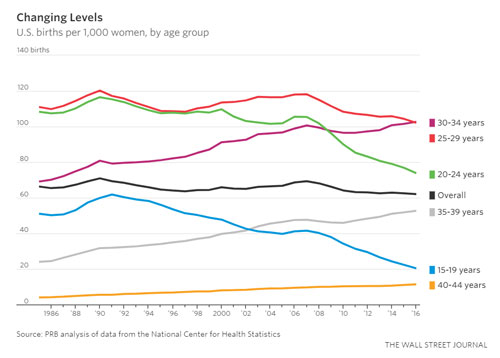A Tricky Balance on Birthrates
This chart, from Jo Craven McGinty’s Wall Street Journal article on teen pregnancy ultimately presents the United States with an existential choice:

The positive headline masks a matter that’s potentially of grave concern. Not just teenagers, but every age group below 30-44 is down. That’s not a health trend, if we consider population to be a positive indicator.
When this topic comes up, we hear a lot about replacement levels and the number of children each woman has, but nobody ever mentions how rate matters. Consider a family that has historically had its first children at around 20 years old. If that family moves to first children at 40, that reduces the rate at which each generation produces the next even if every woman ultimately has the same number of children as before.
Under the first rate, when one woman is 60, she’ll be witnessing the birth of her first great grandchild, for a total of four generations. Under the slower rate, her daughter will only be halfway to having her first child, so two generations, and grandma will probably never meet a great grandchild.
Naturally, there’s a balance to be found. We don’t want teenagers bringing children into an overpopulated world to parents who aren’t able to care for them. But that doesn’t change the fact that the overall rate of births is down. Older women aren’t making up for the reduction among younger women and girls, in large part, probably, because they just have less time to add to the number once they start.
[box type=”note” style=”rounded”]To Our Readers: We need your support to challenge the progressive mainstream media narrative. Your donation helps us deliver the truth to Rhode Islanders. Please give now.[/box]
Of course, however much we may be able to draw lines and analyze the data, we can’t micromanage these sorts of trends, meaning that there may be no way to increase childbirths in women’s 20s without also stopping the drop among teenagers. If we consider this to be a problem for our society, the fixes are largely cultural and are therefore long-term projects.
One thing we should do, however, is to eliminate whatever part of this trend is attributable to young adults’ lack of opportunity.


